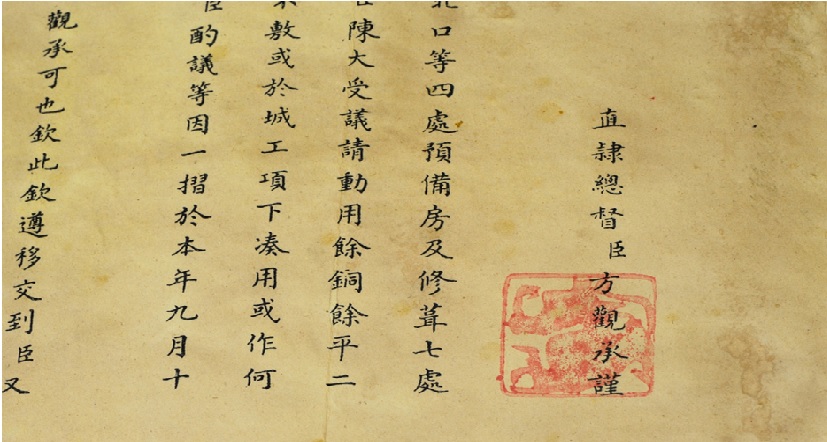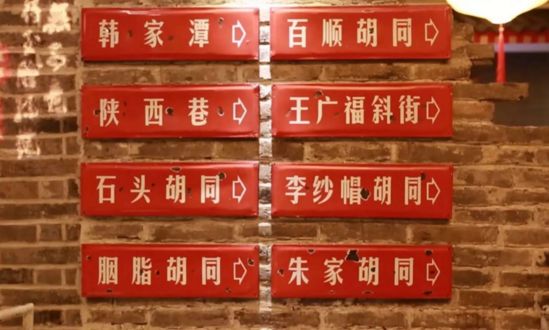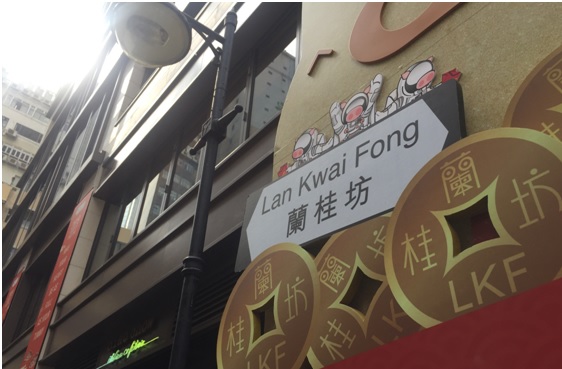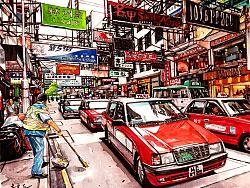Traditional Chinese vs. Simplified Chinese
Fast Facts About the Two Chinese Writing Systems
|
1 |

[Chinese characters on an official report from a senior governor to the emperor, Qing Dynasty]
There are two distinct sets of WRITING SYSTEMS for the Chinese language - the Traditional Chinese and the Simplified Chinese.
You might be wondering: why do the Chinese people write in two different versions? WHAT ARE THE DIFFERENCES between the Traditional and Simplified Chinese? Which language should I learn? Which version shall I translate my text into? Let's get ready to dive deeper by choosing one of below headlines to read along:
- The Core Difference Between the Traditional and Simplified Chinese - the Structure of Characters
- Different Usage of Words / Phrases Between the Simplified & Traditional
- Different Numbers of Characters in These Two Sets
- Traditional & Simplified - Why Do the Chinese People Write in Two Different Sets of Characters?
- Historical Evolution of the Traditional and Simplified Chinese
- The Principals Behind the Simplification Process
- Where are the Traditional and Simplified Chinese Used Respectively
- Traditional vs. Simplified, Are They Mutually intelligible?
- Simplified, Traditional - Are they Mandarin or Cantonese?
- Debates Over Pros & Cons of Simplified Chinese and Traditional Chinese
- Simplified vs. Traditional, Which Version Should I Study if I Plan to Learn the Chinese Language?
- Simplified Chinese & Traditional Chinese, Which One Should I Choose For My Translation?
The Core Difference Between the Traditional and Simplified Chinese - the Structure of Characters
The most noticeable difference between the Simplified Chinese and Traditional Chinese might be the appearance / structure of the characters. The Traditional characters are usually more complicated and use more strokes / radicals, while the Simplified characters are in simpler structure with fewer strokes. Check below for an example:

As its name indicates, Traditional Chinese (sometimes also as "Chinese Traditional") is a traditional version of text that had been written by Chinese people for thousands of years. It’s a very complicated writing system – as you know, Chinese language doesn't use alphabetic/phonic letters the way Western languages do – we use characters that can stand for a variety of things. These characters have grown very subtle and complex over the long time of history, and learning to write Chinese characters could sometimes be a challenge even for the natives.
Simplified Chinese (sometimes also as "Chinese Simplified ") is exactly that – simplified. The Simplified Chinese script originally was absolutely no different from Traditional Chinese in terms of either vocabulary and syntax, just in the fact that most of the characters used to write out the text were literally simplified – many subtleties were removed and the characters were reduced to more basic patterns that were easier to memorize and write out.
Below is a small table for comparison of a few Chinese characters between their Traditional and Simplified writings:
| MEANINGS | TRADITIONAL CHINESE CHARACTERS | SIMPLIFIED CHINESE CHARACTERS |
| Picture | 圖 |
图 |
| Dot | 點 |
点 |
| Body | 體 |
体 |
| Chain | 鏈 |
链 |
| Grain | 穀 |
谷 |
| Far | 遠 |
远 |
| Discuss | 論 | 论 |
| Dragon | 龍 | 龙 |
| Clock | 鐘 | 钟 |
As we can easily notice, the patterns of the Traditional version of the characters appear much more complex than their Simplified "counterparts".
All Chinese characters, be it Simplified or Traditional, were originally the same. In light of this, while some complicated characters were changed into simpler versions in the simplified Chinese system, a certain number of them still carried over without any change. This was because these unchanged characters were already so simple that there was no need to re-structure them for further simplification. Therefore, we can see that both the Traditional and Simplified system share many characters in identical forms..

[Examples of differences between the SIMPLIFIED & TRADITIONAL CHINESE]
Different Usage of Words / Phrases Between the Simplified & Traditional
Besides the different written forms of individual characters, we can also see the different use of words / vocabulary between the Simplified and Traditional.
For example, "ball pen" is called “圆珠笔” in Simplified Chinese but “原子筆” in Traditional Chinese, Stallion is called “斯大林” in Simplified Chinese but “史達林” in Traditional Chinese, and North Korea is called “朝鲜” in Simplified Chinese but “北韓” in Traditional Chinese.
However, such differences are not inherent in the "two languages" but rather in the groups of people who are using them. Especially, exchange between Mainland China and Taiwan was very few due to political reasons, which resulted in the difference in languages, resulting in the different language habits that had been more obvious in technical terms since the 1980s. What’s more, there are also differences between Traditional-Chinese speaking regions such as Taiwan and Hong Kong. Therefore, some pointed out that the more precise terms should be “Taiwan Chinese” or “Hong Kong Chinese” , instead of “Traditional Chinese”.
In computer terms, Traditional Chinese usually refers to “Taiwan Chinese” because Taiwan was earlier in developing computers in Chinese and had more population using them. Therefore, Traditional Chinese versions of most software are using phrases and translations from Taiwan, which are popular in Hong Kong, Macau and other Traditional-Chinese speaking communities. However, the increasingly different phrases of Taiwan and Hong Kong have caused many open-source software to publish two versions for Taiwan Chinese and Hong Kong Chinese that each uses translations from respective places, such as GNOME and KDE.
Below is a small table for a quick comparison about a few programming terms:
| ENGLISH WORDS | SIMPLIFIED WORDS | TRADITIONAL WORDS |
| algorithm | 排序算法 | 演算法 |
| application | 应用程序 | 應用程式 |
| argument | 自变量;引数 | 引數 |
| array | 数组 | 陣列 |
| asynchronous | 异步 | 非同步 |
| class | 类 | 類別 |
| class library | 类库 | 類別庫 |
| code | 代码;源代码 | 程式碼 |
| component | 组件 | 元件 |
| constant | 常量 | 常數 |
| constructor | 构造函数 | 建構函數 |
As professional language translators, we are sensitive to the differences between these two language sets.
Different Numbers of Characters in These Two Sets
Besides re-structuring the individual characters for simplification, the Simplified Chinese also employs a less number of characters in its system. Originally, the Traditional Chinese expresses each different meaning/concept/word using one unique character. In Simplified Chinese, one single character sometimes could represent a few different words of different meanings that have same pronunciations.
In addition, not every Chinese characters had been simplified -only some of the characters with very complicated structures had been changed. The others remained the same. So you can safely assume that the Simplified Chinese has fewer characters than the Traditional system - this might be a good news for those who wish to learn Chinese language.
In year 1955, the Ministry of Culture and the Text Reform Committee of China had published the "First Batch of the Variant Chinese Characters List", in which 1,055 variant Chinese characters were abrogated. In year 1964, the Ministry of Education, Ministry of Culture and the Text Reform Committee of China had jointly issued the "General List of Simplified Chinese Characters", which contain a total of 2,238 Simplified Chinese characters, the average numbers of strokes of the Simplified characters being reduced to 8-11 from the average 16-19 in their Traditional counterparts.
Traditional & Simplified - Why Do the Chinese People Write in Two Different Sets of Characters?
There was basically ONLY ONE writing system - before 1950's.
As its name indicates, Traditional Chinese (sometimes also as "Chinese Traditional") is a traditional version of text that had been written by Chinese people for thousands of years (with many variants as you can imagine). Actually there wasn't a concept/name for "Traditional Chinese" previously - until the "Simplified Chinese" system was built up in comparison in the modern time.
In the 1950s, the Chinese government decided to "simplify" the written forms of many complex characters, with a purpose to make the reading and writing the language text easier for its then largely illiterate population. The Ministry of Culture and the Text Reform Committee of China published the official list of standard Simplified Chinese characters, marking the national roll-out of Simplified Chinese system. (P.S. This ambitious attempt turned out to be highly successful and the literacy rate of China today is among one of the highest in the world.)
That was the beginning of the divide of two distinct writing systems for Chinese language.
Historical Evolution of the Traditional and Simplified Chinese
Chinese characters (汉字, Hanzi) are one of the world's oldest ideogram, with a long history of over 3,500 years of development and evolution. The oracle inscriptions on bones or tortoise shells of the Shang Dynasty (商朝 c. 16th-11th century B.C.) unearthed in Yin-Xu (殷墟) has been the earliest "well-developed" Chinese characters (Hanzi) ever discovered and identified. After its inception and early development, the Chinese characters have gone through a long period of evolution. Since the earliest Chinese language symbols were carved into animal bones and tortoise shells 3,500 years ago, countless characters had fallen in and out of use, and strokes / radicals have been added and removed after that.

[The evolution of the forms for the same character 马.]
We call all of the different forms / styles / variations as Traditional Chinese characters - in a broader sense. To some extent, we may say that even the Traditional Chinese characters themselves are the results of a constantly simplification process - they are the simplified abstractions of various graphic symbols. In modern times, the standards of Traditional Chinese (mainly used in Hong Kong and Taiwan) is believed to derive from the Royal Standardized Characters (同治版《钦定正体字》) published in Year 1874 by the Qing Dynasty government, a biggest list to include the most of the standardized characters by then.
In the 1950s, as part of a movement to raise the literacy rate of the nation, the new Chinese government decided to restructure and simplify some of the most complex characters, hence the divide between 繁体字 (fántǐzì, traditional characters, or more literally the “complex characters”) and 简体字 (jiǎntǐzì, simplified characters, or literally the "simple characters").
The simplification process was completed and new character system adopted before 1960, and it's been in use in Mainland China ever since. Singapore and Malaysia also developed their own sets of simplified characters, which happen to be the same as that used in Mainland China.
The Principals Behind the Simplification Process
There were 6 methods employed to simplify the Chinese characters, namely:
1) change of radicals;
2) deletion of parts;
3) homophone substitution;
4) total remake;
5) simplified analogy;
6) regularization of cursive script.
Simplification of complex Chinese characters followed the principles of “simple elaboration of the theories of the predecessors with no original ideas of one's own”, “respect of established rules with steady and gradual advance”. That means that we must preserve as many as simplified forms that have long been popular among the folks with best efforts by simple collection, collation and modification in compliance with the principle of “respect of established rules with steady and gradual advance”. It refers to reduction of numbers and abolishment of variant Chinese characters of the same meaning and pronunciation.
Where are the Simplified and Traditional Chinese Used Respectively
Traditional Chinese is used in Hong Kong, Macau and Taiwan region, as well as many overseas Chinese communities, for example, in many Chinatowns in the North America, particularly those old ones, it's more often to see things written in traditional characters. If you plan to do business in these places, you may need to translate your English text into Chinese Traditional.
Simplified Chinese is the official language text in Mainland China and Singapore. However, it's also becoming increasingly common in overseas Chinese communities, especially those new ones, as more and more people emigrated from Mainland China to these places. If your target audience reside in these two places, please translate your documents into Chinese Simplified.
|
REGION / DISTRICT | WRITING SYSTEM |
| Mainland China | Simplified Chinese | |
| Taiwan | Traditional Chinese | |
| Hong Kong | Traditional Chinese | |
| Macau | Traditional Chinese | |
| Singapore | Simplified Chinese | |
| Malaysia | Simplified Chinese | |
| Overseas Chinese Communities | It depends... | |
Traditional vs. Simplified, Are They Mutually Intelligible?
The existence of two different sets of Chinese text may hinder the smooth communication between different Chinese-speaking communities, as we had previously illustrated about the differences in both characters and vocabularies between the Mainland Chinese language and the Taiwan Chinese language.
However, it might not be as huge of a problem as you might reckon - they are not like English vs. French. Many characters are still very SIMILAR (if not totally identical) in both systems, and for those characters that do use different written forms, the difference is often a familiar component, like a radical.
Most educated Chinese speakers, either using Simplified or Traditional, usually have reasonable familiarity with the other character set they don’t read and write daily. Most of the Mainlanders find them quite comfortable reading the road signs, restaurant menus and even newspapers & magazines printed in Traditional Chinese when they visited Hong Kong, and the netizens from Taiwan won't feel too difficult to browse online Mainlander forums discussing political issues in Simplified Chinese.
In this sense, YES we may claim that these two sets of writing systesm are SIMILAR and to a large extent "Mutually Intelligible".
Simplified, Traditional - Are they Mandarin or Cantonese?
When approached by clients for translation services, we often see questions asked about the target languages. Chinese Simplified, Chinese Traditional, Mandarin, Cantonese, which one should I choose?
First, we, as professional language translators, would like to get a few basics cleared up: Mandarin and Cantonese are just dialects of spoken Chinese, NOT forms of written Chinese, while the Simplified and Traditional are the forms of the written text, not spoken dialects. These terms are often tossed about freely, as if they were all the same thing, but clearly they AREN'T. These are two SPOKEN styles/dialects of Chinese language. As an official spoken “dialect”, Mandarin is widely used in Mainland China, Taiwan area and Singapore. Cantonese is specifically targeted to Hong Kong audience only.

[People in Mainland Chinese Speak Mandarin, and write in Simplified Chinese]
Mandarin and Cantonese are the two most spoken form of Chinese (there are in fact another 20 spoken dialects in China). Cantonese has nine tones while Mandarin only has four, which leads some to argue it’s easier for Cantonese speaker to learn Mandarin, but harder the other way around. Mandarin speakers and Cantonese speakers would have a hard time understanding each other given the huge difference in tones. That’s why when producing radio or TV advertising or any other communication involving the spoken language, you should cater for the relevant language preference.

[People in Hong Kong speak Cantonese, and write in Traditional Chinese]
So can we say that Mandarin speakers use Simplified Chinese and Cantonese speakers use Traditional Chinese? Not really. That’s a major misconception. Those from Southern China use Cantonese but write Simplified. Those from Taiwan speak Mandarin but write in Traditional Chinese. The only thing you can be sure of is that people from mainland China use Simplified Chinese characters. If you can't decide which variety you need your documents translated into, why don't just write to us, and the professional linguists at ACE CHINESE TRANSLATION will help identify the correct variant for you.
(This article is mainly about a COMPARISON between Chinese Simplified and the Chinese Traditional. For better understanding of this subject, it's recommended to also read our article "Mandarin vs. Cantonese".)
Debates Over Pros & Cons of Chinese Simplified and Chinese Traditional
Like all beings in the world, simplification of Chinese characters comes with two sides. On one hand, there are 3 advantages:
1. Simplified Chinese characters have less strokes to reduce time of writing.
2. Simplified Chinese renders more beauty of the modern time by presenting the sense of simplification.
3. Simplified Chinese does not comprise any factor in perfect combination of phonetics, form and meaning.
Of cause, we won't neglect the negative sides:
1. May phonological characters are bewildering in meaning once simplified. For example, “江” is a phonological character that is hard to guess its pronunciation from parts and coinage style.
2. Traditional Chinese has the classical beauty. Chinese calligraphy and traditional Chinese painting are thought of as the same school of art. Traditional Chinese characters are in themselves beautiful traditional Chinese paintings that inspire respect out of people. For example, “麗” is the Traditional Chinese of “丽”. Isn’t that a beauty?

The debate over "simplified Chinese vs. traditional Chinese" is an ongoing dispute concerning Chinese orthography among users of these two sets of Chinese characters. It had somewhat stirred up heated responses from supporters of "both sides" in Mainland China, Hong Kong, Macau, Taiwan, and among overseas Chinese communities, where people began to get emotional about the implications of political ideology and cultural identity of the writing method of the characters.
One of the examples that is frequently referred to by the Traditional Chinese supporters is the character "love". 爱 ài (love) : As you can see it in the picture, the Traditional version of it has many strokes and the Simplified one has less. In the traditional character of love, there is a heart (心 xīn) in the mid of the pattern, but the simplified character comes without that. Traditional Chinese supporters would claim that the Simplified version is "loving someone or something without putting in your heart".

Proponents of Simplified Chinese wouldn't agree on this argument. They pointed out that the purpose of the characters are to convey meanings in flow of context, and the love is the love when it's included in a same phrase/sentence without any slightest change of connotation, be it the Traditional 愛 or the Simplified 爱. Moreover, as many alphabetic languages like the English do not have any specific meanings associated with the writing methods of their alphabets, do they have the problem of "losing heart in love"?
Anyway, debates over the pros and cons about these two language sets can comprise a big topic themselves and we can't include all of the point of views within this small article.
Simplified vs. Traditional, Which Version Should I Learn if I Plan to Study the Chinese Language?
We don't have a straightforward simple answer to this question -- there is no hard rules for that, and you'd better be clear about your purpose for learning Chinese language.
Who are the Chinese speakers that you would like to communicate to? Where are they from or where do they currently live? If you are trying to do business and build relationship with someone in the Mainland China, Simplified Chinese is of course your top choice. If you expect to interact mostly with people from Taiwan, Hong Kong, or Macau, or to travel to one of those places, I would naturally suggest you to take on the Traditional Chinese.
If you are a huge fan of Traditional Chinese culture and would like spend some decent time about the history, art or early literature of China, go for Traditional Chinese. Interested in business and modern technologies? Simplified would be more recommendable.
Both sets of characters come with their own rewards and challenges. If you stick with learning Chinese long enough, familiarizing yourself with both systems will only deepen your understanding and appreciation of the Chinese language. At the very least, you should learn your radicals.
If none of these above applies to your situation and you still don’t know which one to choose, I would mention to you that the Simplified system is used by most of the Chinese speaking population, and as its name suggests, it's simpler and easier to get started with.
And don't forget what we analyzed previously - they are mutually intelligible, to a large extent.
Simplified Chinese & Traditional Chinese, Which One Should I Choose For My Translation?
The above information may sound a little complicated to non-Chinese speaking people. To make things simple, let’s put it this way:
中文翻译 中文翻譯 |
REGION / AREA | TRANSLATE INTO |
| Mainland China | Simplified Chinese, in Mandarin style | |
| Taiwan | Traditional Chinese, in Mandarin style | |
| Hong Kong | Traditional Chinese, In Cantonese style | |
| Macau | Traditional Chinese, in Cantonese style | |
| Singapore | Simplified Chinese, in Mandarin style | |
| Malaysia | Simplified Chinese, in Mandarin style | |
| Overseas Chinese Communities | It depends... |
Need to translate English to Chinese Simplified or to Chinese Traditional ? Tell us who your target readers are, then leave the other things to us! Feel free to -

